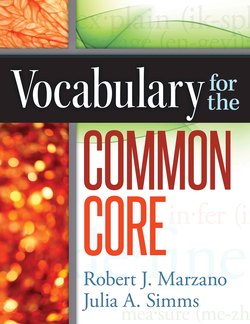Читать книгу Vocabulary for the Common Core - Robert J Marzano - Страница 6
ОглавлениеIntroduction
In 2009, the National Governors Association Center for Best Practices (NGA) and the Council of Chief State School Officers formed the Common Core State Standards Initiative. Their goal was to create a set of statements about what students should know and be able to do as a result of schooling that would be common to all states. Shortly after the Common Core State Standards (CCSS) were released in 2010, forty-five of the fifty states adopted them.
The advent of the CCSS presents educators in the United States with new resources and opportunities, but also with significant challenges. Teachers need to understand the ideas behind the new standards, how they differ from their state’s previous standards, and how to implement them in their classrooms. To help educators address these challenges, researchers at Marzano Research (since renamed Marzano Resources) sought to develop tools and strategies that educators could use to successfully implement the CCSS in their classrooms and schools. As they analyzed the CCSS and talked to teachers across the United States, they realized that vocabulary instruction was an important area of need. The CCSS prioritize students’ acquisition of a wide range of academic and domain-specific vocabulary, and educators needed research-based strategies and processes that would help them implement CCSS-aligned vocabulary instruction in their classrooms and schools. This book was written to meet that need. Other tools and resources for the CCSS are available in the book Using Common Core Standards to Enhance Classroom Instruction and Assessment (Marzano, Yanoski, Hoegh, & Simms, 2013) and online at MarzanoResources.com/commoncore.
A book that focuses exclusively on vocabulary is not common among the many (otherwise very useful) books that have already been written about how to implement the CCSS. Previous books have focused on the history and organization of the CCSS (Kendall, 2011; Reeves et al., 2011; Rothman, 2011), thinking skills within the CCSS (Bellanca, Fogarty, & Pete, 2012), assessments and the CCSS (Daggett, Gendron, & Heller, 2010), using the CCSS within existing instructional frameworks (Burris & Garrity, 2012; Crawford, 2012), and leading implementation of the CCSS (Dunkle, 2012). Others have offered curriculum maps for the CCSS (Common Core, 2012a, 2012b, 2012c) and strategies for achieving success with the CCSS (Silver, Dewing, & Perini, 2012). This omission is unfortunate, since the CCSS present unique demands on the breadth and depth of students’ vocabulary knowledge and, in turn, on the instructional techniques teachers must employ in their classrooms. For instance, while students must acquire an attitude of exploration and curiosity toward new words, teachers must identify a manageable number of CCSS vocabulary terms for direct instruction; help students understand, internalize, remember, and use those terms; and assess and track students’ progress with the terms. This book was written to address those challenges.
The book includes three parts. Part I contains chapters 1–4. In chapter 1, we explain the importance of vocabulary knowledge and instruction, factors that affect students’ vocabulary development, how vocabulary influences students’ reading ability and achievement in school, and the research supporting direct vocabulary instruction as an effective strategy for increasing students’ vocabulary knowledge. Chapter 2 presents a six-step, research-based process for vocabulary instruction that guides teachers as they introduce and explain new terms and prompt students to create descriptions and graphic representations for terms, interact and play with terms, and refine their understanding of terms. In chapter 3, we describe the process we used to identify and organize two types of vocabulary terms from the CCSS: academic terms and domain-specific terms. Finally, chapter 4 explains how to build a classroom, school, or district vocabulary program and how to assess and track students’ vocabulary knowledge.
Part II contains the academic terms (in this case, cognitive verbs) that we identified from the CCSS, organized into twenty-four categories. These verbs describe how students should interact with the knowledge and skills they learn in class.
Part III contains the domain-specific English language arts (ELA) and math terms that we identified from the CCSS, organized into 116 measurement topics (groups of related words that can be taught together).
The appendix lists all academic and domain-specific terms alphabetically with identifiers so readers can easily find specific words.
